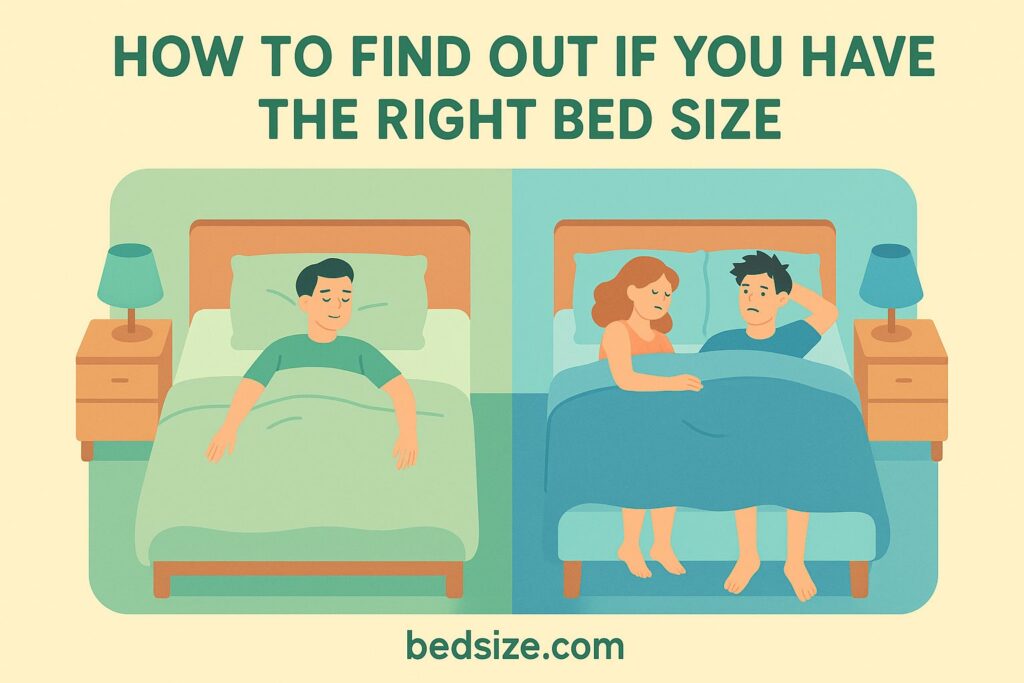🛏️ Do You Have the Right Bed Size?
How to spot the signs of right (or wrong) bed size — and what to do if your bed is holding your sleep back.
A bed that’s too small can ruin your sleep. But how do you know when it’s time to upgrade—or adjust your setup? Let’s break it down for solo sleepers and couples, with signs to watch for and real-world solutions that can change your nights (and your mornings).

👤 For Solo Sleepers
✅ Signs your bed size is right:
- You sleep through the night without feeling restricted.
- You can stretch out fully in both directions.
- You never feel like you’re about to fall off the edge.
Keep doing what you’re doing! You’ve likely found a bed that supports your sleep habits and body size.
❌ Signs your bed might be too small:
- Your feet hang off the end — a telltale sign it’s too short.
- You wake up curled or sideways across the bed to fit.
- You constantly shift to avoid bumping the bed frame or wall.
🔧 What to do:
- Upgrade the length: If you’re over 6 ft (183 cm), switch to a Twin XL, Queen, or California King (all are longer than standard beds).
- Upgrade the width: Feel cramped? Move up from a Twin to a Full or Queen—even if it takes up more room, your sleep is worth it.
- Reposition your bed: Moving it slightly away from a wall or headboard can improve usable space.
🧠 Pro tip: A mattress topper won’t fix size, but it can add comfort if you’re stuck with a firm or narrow mattress temporarily.
🧑🤝🧑 For Couples
✅ Signs your bed size is working:
- You both sleep without waking each other up.
- You don’t fight over space or covers.
- You wake up feeling rested—not squished.
❌ Signs your bed is too small:
- One partner constantly sleeps on the edge or pushes the other.
- You experience heat buildup or duvet battles every night.
- Restlessness or snoring from one partner ruins the other’s sleep.
🔧 What to do:
- Size up: Go from Queen to King (or even Super King in Europe). The extra width makes a massive difference in sleep quality.
- Split solutions:
- Try Scandinavian-style separate duvets—no more cover wars!
- Use two separate twin mattresses in the same frame to isolate motion.
- Rotate positions: Occasionally switching sides or adjusting head-to-foot alignment can reduce pressure points (and arguments).
😴 Consider this: Sleep specialists say one in four couples now choose a “sleep divorce”—separate beds or bedrooms to improve rest. It’s not the end of romance—it’s the beginning of better mornings.
📏 Bed Size Problems: What the Signs Mean
| Sign | Possible Cause | Solution |
|---|---|---|
| Feet hanging off the bed | Bed too short | Upgrade to Twin XL, Queen, or Cal King |
| Waking up in a ball | Too short or narrow | Get more length & width |
| You roll toward each other | Sagging mattress or too-small bed | Upgrade bed or replace mattress |
| Duvet tug-of-war | Too small duvet or restless partner | Use two duvets or a wider one |
| Feeling “lost” in the bed | Bed too large for solo sleeper | Layer pillows/throws for a cozy setup |
🛌 Still Not Sure?
Try the “Starfish Test”: Lie on your back with arms and legs spread out. If any part of you hits the edge—or feels close to falling—it’s time to go bigger.
Bonus: Try our related guides
- Best Bed Size by Sleeping Position
- Bed Size for Couples: What to Choose and Why
- Bed Length Guide for Tall Sleepers
🪟 Fun Facts & Quirks
- In Finland, sleep divorces are so common there’s a word for it: erilliset peitot (separate duvets).
- IKEA’s European beds often default to 200 cm length, but taller sleepers can order 210 cm versions.
- A UK “Super King” is not the same as a US “King”—check your region’s sizes carefully!
🧭 Final Word
Your bed shouldn’t just “fit the room”—it should fit you and your sleep habits. If your bed leaves you stiff, tired, or sharing space you don’t want to share, it might be time to rethink your setup.
👉 Ready to find your fit?
Start with our Complete Bed Size Comparison Guide and sleep smarter tonight.